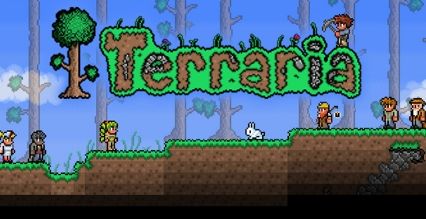
- Format: 360 (version reviewed), PS3
- Unleashed: Out Now (360 worldwide, PS3 in NA), TBA (PS3 in PAL regions)
- Publisher: 505 Games
- Developer: Re-Logic
- Players: 1-4 (offline), 1-8 (online)
- Site: http://www.terraria.org/
Terarria has been described as the 2D Minecraft. This is accurate and for those of you who like Minecraft, to save you time, we’ll say that if you enjoy it but want an experience which is a little bit more linear and streamlined, then Terarria is for you. Review done!
For those that don’t play Minecraft, let’s take a step back from the end of the review and break down Terarria for you. You exist in a 2D open world, which is populated by all sorts of wee beasties. You can customise the look of your character, which is a funny process as with some of the parameters you are literally changing 2-3 pixels due to the 8-bit art style. Armed, initially, with an axe and pickaxe you’ll be able to dig up land and cut up trees. You also enter the game with the ability to defend yourself with a simple copper sword. There are no real objectives as the game is completely open world; however it does push you in directions, not least through the achievements/trophies on offer.
The developers want you to explore, not just the surface, but up high and down low. You can build steps and platforms, and dig deep into the ground. As you do so, you collect more wood, copper, stone and other materials which can all be used to construct new weapons, potions and buildings. There are a range of computer controlled characters to meet along your journey and you can build houses for them. Each character has their own attributes and can assist or sell you different types of resources to help you with your journey.
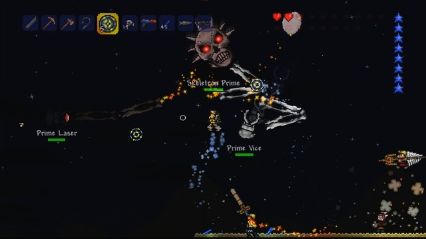
As with Minecraft, the day and night cycle requires your attention. At night zombies and other nasty creatures will appear and threaten you. Taking safe refuge inside your house or a safe shelter is a must if you are to survive the night. This means that more often than not, you will use the daytime to prepare for the night time. If there is a purpose to this type of game it’s to firstly survive, explore and then develop yourself as much as you can to be able to experience the full richness of the world in which you inhabit. Similar to life itself then!
The art style is 8 bit, but the visuals are engaging, colourful (during daytime) and crisp. Character design is inventive and the developers have allowed their imaginations to run wild with the types of enemies and animals you will encounter. There is no common theme; they are strange, exotic and totally random in style, whilst referencing a wide range of other genres as a tip of the hat to seasoned gamers.
A game like Terarria is also only as good as its user interface and controls. On PC you can get away with more complexity and confusion, but on a console the controls are distilled so that they work with the limitations presented by a traditional controller. We found that they work very well in-game. You control both your character and a cursor for targeting at the same time (left stick for character and right for your cursor). By clicking in the right stick you can switch the cursor between being coupled to your character and moving in relation to him (or her), or you can de-couple it and make it semi-independent (it will still only go so far in any direction away from your character). Moving through menus is simple and fast. and there are plenty of help and tutorial scripts to go through if you become stumped.

Terarria is a relaxing and gentle game. It’s not completely free of tension or drama – after all there are monsters in it, and you can die. On the higher levels of difficulty those deaths really do hurt you, whereas on easier levels of difficulty you can just continue where you left off. However, there is no rushing in this game, and if you take your time to prepare well and take refuge in safe areas at night, then you can travel through the world without too much harm coming your way.
The music is lovely and the art style really draws you in. The controls work very well and with online play (with full player versus player or without) and local play there are a good number of options to make your experience a social one. Overall Terarria is a delight to play, even for those who could never get into Minecraft. Whilst 2D might be perceived as a watered down experience it is, ultimately, for some at least an experience which is fun. Less of an ordeal and more of a game.


Payday: The Heist burst onto the gaming scene in the Autumn of 2011, for PS3 and PC. Two years later Overkill are back with the sequel. Will it be a steal?
Influenced by Valve’s Left 4 Dead, the first Payday game offered four player co-op missions, set in urban environments. However, instead of shooting zombies, the player was tasked with stealing money, jewels or whatnot and then trying to escape, whilst being attacked by waves of cops.
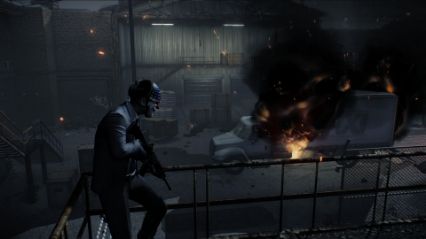
Designed using the Diesel engine, the game was no looker (it looked in our opinion worse than Left 4 Dead), but it was perfectly functional, and more importantly smooth and fast. Whilst Payday 2 uses the same engine it seems to look better, and on a decent PC is quite pleasing to the eye. Don’t expect Battlefield 3 graphics, but it still runs very nicely. We have not seen a PS3 or 360 version yet to compare.

Payday 2 feels much more like a persistent crime universe and achieves this by utilising a game mechanic called CRIMENET. CRIMENET is an in-game platform which allows you to see potential ‘jobs’ becoming available for you to play on a map of the city. Each job will be rated depending on its difficulty. Some will be easy, whilst others will really require you to level up before starting, and ideally partnering with another one to three additional players. One large difference between Payday 1 and 2 is that in single player mode there is no friendly AI playing on your side. You will be truly alone.
Payday 2 allows you to level up – XP can be spent on perks which improve characteristics based upon your class. You can have assets across classes, but you cannot max out multiple classes. Money from the heists can be used to purchase better weapons and tools of the trade, so the more you play the more you can improve using two distinct currencies, operating on two different speeds of update. The skill trees available to you are linked to the following classes:
- Ghost, who offers stealth type benefits
- Technician, who can operate and use gadgets such as sentry guns
- Enforcer, who has brute strength, ideal for carrying bags of cash and running at the same time
- Mastermind, the player with intellect able to intimidate civilians and cops, even getting them to join your ranks for a period.

Currency can be used on weapons, but can also be used to unlock pre-mission help, such as codes for security systems and extra briefing information. These are not required to complete the mission, but can make your life a lot easier, and perhaps allow you to escape with more loot. Hence it’s a potential investment decision. There are at least 30 different locations and each time you play a mission in one of them, all the elements are randomly changed. You’ll never have the exact same experience again, and that’s before you take into account the random nature of your human co-op partners.
The game looks like it’s a lot of fun to play. Left 4 Dead, its original reference point, managed to create that sense of fun, panic and at times humour caused by the missteps of your co-op partners. In contrast, Payday always seemed a more serious proposition, due to the subject matter and lack of zombies. Payday 2 keeps that serious edge, but the level we saw seemed really fun, with lots of potential scenarios for reenacting scenes from films such as Heat, or even the Die Hard style movies with urban shootouts. Overkill have gone out of their way to find ways of rewarding players for taking part, and this title has a good chance of finding a community of players keen to develop their career in crime.
]]>
Film director Josef Fares has joined with developers Starbreeze to create a new digital only title, Brothers: A Tale of Two Sons.
Imagine the humour and storytelling of Fable mixed with the control scheme of the recent Nintendo Land Animal Crossing mini game (played with only two people) along with a puzzle game such as Lostwinds and Journey and perhaps you have an idea of what makes Brothers. The two brothers are seeking a cure to save their father and you need to guide them in their quest.
We had the opportunity to play through an early build at a preview event. The early puzzles are not particularly challenging, but ease you into the main mechanic which you will be utilising throughout the game where you control one brother with the left control stick and left trigger, and the other other brother with the controls on the right side of the controller. The camera is certainly being challenged as it has to adjust constantly as you move your two playable characters in opposing directions. On the whole it fairs pretty well. However, Starbreeze have wisely added user control to the camera via the shoulder buttons.
We experienced a puzzle which involved crossing a field. In the field are a number of haystacks and climbable rocks. Stopping you crossing the field with ease is an attack dog (cute to look at, but fearsome if it gets to one if your characters). The ‘puzzle’ is how to utilise the two different characters simultaneously to cross the field without being mauled. You move one character to safety whilst distracting the dog with your other brother.
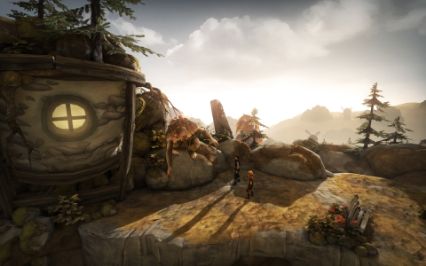
When we managed to get into a conversation with Josef, it became clear that he is very proud of the small embedded stories littered across the game. He stressed that very few moments of gameplay are repeated throughout the entire three-to-four hour game experience. Each scene should stand alone without becoming a repeating theme punctuating the game with a regular rhythm. With regard to those small stories, these are moments of interaction which are short stories in their own right. Each brother can achieve different results by interacting with non player characters, animals and scenery. Some interactions will be heart warming, some sad and many comedic in tone.
Starbreeze claim three to four hours of gameplay, with few reused puzzles. However, whether the game will hold our interest will depend on how the core puzzle mechanic evolves, in addition to the narrative hooking you in. Do we care and will the story have enough twists and turns to keep us wanting to complete the next dual character puzzle in the next scene?
Visually it is a cross between Fable and Lostwinds, but we are told that later levels become much darker and more gritty. The sound design and music is gentle and absorbing. Could this be the next Journey? Visually it is far more traditional, so it won’t have the immediate impact based on its looks; however, its gameplay could draw people in. It’s engaging and interesting based on the small section of gameplay we have seen so far.
Watch out for the Brothers: A Tale of Two Sons on Xbox Live Arcade and PlayStation Network in May 2013.
]]>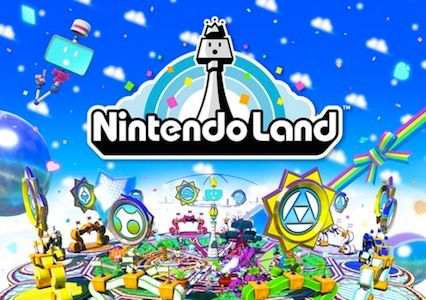
- Format: Wii U
- Unleashed: Out Now
- Publisher: Nintendo
- Developer: Nintendo
- Players: 1-5 (offline only)
- Site: http://nintendoland.nintendo.com/about.html
We have Pac-Man clones. We have a simplified FPS adventure experience. We have arena based third person shooters. We have a dumbed down 3D racing game. Alongside these are some nice, non-offensive games which would be fine on a tablet, but with the dual screen gimmick thrown in as a way to reach out to the ‘casual’ gamer. All of it works and none of it is broken, but one wonders if any of the respective target groups need it. Surely they have something similar, better and more satisfying elsewhere without the £50 price tag?
Let’s go through some of the highlights included in Nintendo Land.
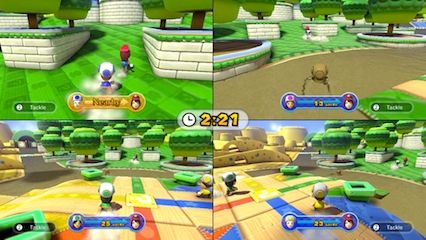
Mario Chase: A great competitive game. You can have up to four players chasing one player around a large outdoor 3D arena. The player being chased has the gamepad screen and can see both where they are running and an overview of where their opponents are. The other players share the TV and can only see what is immediately in front of them. The arena is split into coloured areas, and the game encourages each of the chasing team to call out where they last saw the player being chased, e.g “he’s in the red sector”. This results in some great social action in the living room. It looks pretty and it’s fun.
Luigi’s Ghost Mansion:
Imagine old fashioned Pac-Man, with greatly improved graphics and you’ll be able to visualise this title. As with Mario Chase, the player with the gamepad can see the whole map, themselves and the other players. The other players share the TV and can only see their own movements. The gamepad player is a ghost and tries to ‘catch’ the other players one by one. In turn they have torches (with batteries which run out quite quickly), with which they try to light up and zap the ghost. They know when they are near a ghost as their Wii remote rumbles. Once the ghost is hit with light it can be seen on the main TV for a few seconds before it vanishes again. As with Mario Chase, it encourages shouting and chatting between the players to catch the player with the gamepad.

Metroid Blast:
This can be played single player or multiplayer, either versus or co-op. We think the co-op mode works best. Whilst presented with cutesie 3D graphics, this is a ‘proper’ title with multiple wave based arenas, where mostly you have to defeat ‘X’ number of enemies or collect ‘Y’ number of tokens before you die. One player can be in a mini-metroid style hovering ship, armed with lasers and rockets. Other players will be on foot armed with a laser. There are upgrades available in the map (quake style). It’s a tough game, the levels look good and if you play through to the end it’s quite a challenge which will keep you going for some time.
Zelda – Battle Quest:
The player with the gamepad controls an archer, whilst players with MotionPlus enabled controllers controls sword-swinging ‘Links’. The game controls your actual movement with you just controlling swinging/blocking/shooting. It’s light, it’s pretty, it’s a stroll in the park, and very child friendly.
Ninja Castle:
Hold the gamepad vertically, pointing in the direction of the TV and slide your finger from the bottom to top of the screen to ‘fire’ a shruiken at enemies on screen. It’s a remote gun shooter essentially, with the fire mechanism based upon you flinging shurikens at the enemy. The controls are remarkably tight, and the speed at which you slide your finger really does translate into the speed and distance of the ammunition flying on the screen. This is a great single player game, and a good time waster. It couldn’t be recreated on a tablet, yet uses tablet style controls. A clever game.
Balloon Trip Breeze:
This looks like a relaxing game, but again proves far more challenging after the initial stages (similar to Ninja Castle). You have to guide a balloon across a 2D map. On the map there are various obstacles to get around. You move the balloon by tapping on the gamepad. The image on the pad is a zoomed in version of that on the TV. Whilst the game is good, the WiiU concept seems to have been ‘forced’ a little for this one.
These are just some of the games in Nintendo Land. There are twelve altogether. Some you will play once and never again (Twister Race we mean you), whilst others will be great family/party games if you have the right family, or right friends.
Whilst we used to play Wii Sports and Wii Sports Resort outside of social gatherings to try to improve our scores and times, we haven’t felt the same need with Nintendo Land. Just as a casual title on a tablet might be used to kill ten minutes of downtime, so too Nintendo Land can; but at a high price. Nintendo would be wise to split up these games and sell them for £2 each on the eShop, or the whole compilation for half the current RRP or less.
]]>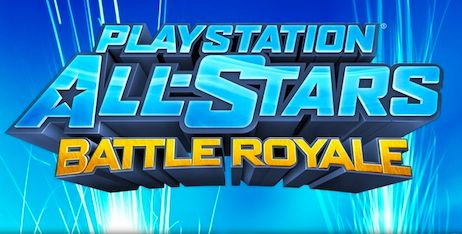
Format: PS3/Vita
Unleashed: Out Now
Publisher: SCE
Developer: SuperBot Entertainment, SCE Santa Monica Studio, Bluepoint Games(PS Vita)
Players: 1-4
Site: http://www.playstationallstarsbattleroyale.com
Despite borrowing characters from some other publishers’ gaming universes, between the PS1 and PS3 Sony have developed a number of very strong characters such as PaRappa, Drake, Kratos, and many more. Hence, this game is pure fan service for those dedicated Sony fanboys who want their own bit of ‘Super Smash’.

Can you name all of them and tell us what game they are from? Actually you’ll know far more than you think.
The core gameplay involves 2-4 characters on screen at once punching the living daylights out of each other. Each ‘stage’ is based on a gaming franchise and is often dynamic, either scrolling or blowing up things affecting the players on screen. Each character controls the same, but has their own very unique style of fighting. Some use guns, some kung fu, some swords or other melee weapons. Balancing playstyles in this type of game is especially hard, and whilst an attempt has been made here it seems certain characters get a better deal. With simple 1v1 matches this isn’t such a problem as one player can counter the strengths of another, but with four players things get very manic as it’s impossible to be able to counter other characters’ weighted strengths with multiple players at once. With a four player match your best bet is to play a strong defence hand and then strike when you have an open window.
Campaign gives each playable character their own story arc to play through, with some simple slide show/static art cards and a voiceover trying to create some kind of narrative (‘some kind’ is the best description), and you play a bunch of characters over a number of stages, until reaching the end boss. On the most basic difficulty this is a pushover, but there are two levels to play through, each with their own selection of CPU characters. This means playing all three difficulties is worth doing as you get a different path to the end each time.

Level settings are taken from game franchises and generally look lovely. They are dynamic too, and events in the background will affect your battle, from moving scenario to off-screen attacks and more.
Single player options include a basic tutorial and a simple ‘trials’ mode. This is in effect a practise mode, where you are set basic challenges. Ideal for portable play, and a nice way of levelling up your profile. However it’s a little shallow and more could have be done with it. The stages in All Stars are detailed and some are quite expansive, so having some comedy and Joe Danger style challenges would have really added depth to the single player mode.
When it comes to multiplayer we have local or adhoc multiplayer with friends called Versus Match. It can be a mixture of human and CPU players based upon the hosts preferences. The meat and veg of All Stars though is the Tournament mode. This is full online multiplayer. Both competitive – with results helping to populate a league table – or a simple ‘Quick Match’ option for someone just wanting a quick fix online. The matches are frantic, a little crazy but a lot of fun. We often had problems getting a match however, constantly being kicked out of servers. Hopefully this issue will be resolved with time.

All Stars supports Cross-Play. Get the PS3 version and you get the Vita version for free. Game saves work between the two platforms. It works really nicely and is superb value.
The Vita version comes free with the PS3 copy, under the ‘cross-play’ brand. It looks practically identical on both systems; but when the camera pans out, it can get a bit hard to see what is going on on the Vita. On the other hand, the trial mode and general fight length support portable play perfectly. The range of moves are great and inventive. Players will find their perfect character, but we kept moving between Nathan Drake who has some great long distance gun attacks and Parappa the Rappa, who fights like a member of the dance group Diversity.
The cutscene animations (where they are present) are great, but too often we get simple static art cards which are poor. In addition, whilst the Sony brand is more adult than Nintendo, the game takes itself just a little too seriously. Some brighter colours and humour across the board would have made the experience far more fun in tone.

Some of the level settings are a little obscure and, unless you really know your Sony franchises, you might be a little lost with regard to the reference points. Either way though they look lovely, and if you want to learn your Sony this is a great way to do it!
Asking if this is a good ‘super smash’ clone is a little unfair. We should be judging it on its own merits, but nonetheless it’s hard to resist a good comparison! The answer is that the game is a good clone, but it has a very distinct Sony flavour of its own. Sure, it needs more content and slightly better production values on the cutscenes to justify a full price tag, but if you love brawling and think the idea of such a wide range of characters playing off against each other is like a PlayStation dream, then you’ll love this. The moves are true to each character’s background, and the stages really do come alive by authentically referencing the game they are built on (Resistance, Sly Cooper for example). The whole package feels legitimate; that it really is Nathan Drake facing off against Kratos or Cole. In addition if you do have a Vita, then the cross-play opens up a new way of experiencing the game, and it’s certainly good value with that thrown in.
It feels a little rough around the edges, as if most of the work went on getting the fight engine working, with the actual imagination in gameplay and modes taking a back seat. You can’t fault that fight engine though. Meanwhile we’re looking forward to the sequel: ‘All Stars Brawl anyone?


The original ‘FAT’ PS3. It’s been replaced twice, each time with a smaller version. Each version with less functionality. No upgrades to actual performance to be found though.
One of the greatest challenges console gaming faces is one of hardware iteration. Traditionally consoles have never had their internal hardware specs increased, as new functionality is added post-launch. We have seen smaller, slimmer and cheaper units released, and some of those have even lost features during the process (compare a PS3 today with one at launch to see the loss of functionality); however we have not seen memory improvements, changes to the CPU or other components. In recent years I can only think of one example where a console has gone against the grain and that was with the DSi, which added more internal memory, an SD card slot, and a slightly faster CPU to compliment its larger screen. This allowed the device to host a poor man’s app store and have some internal non-gaming apps. The core DS games themselves though were not affected and were rarely designed to take advantage of this small ‘bump’ of power available to them.

The 32X which sat on top of your Megadrive making it look, HUGE.
Sega famously released an ‘add on’ console – the 32X – which was designed to add a few more years to the Mega Drive. It’s famous (or infamous) for not working – as it split the marketplace resulting in developers not really supporting it, and sending out mixed messages to consumers about the console’s ‘hedged bet’ strategy on its lifespan. The end game was a lesson learnt that this was not a good strategy. Hence, now we never expect console firms to release upgraded consoles.
But in a world where the console is not the only gadget in town, this policy is coming under strain. Tablets, phones and event smart TVs are competing for our attention. Many, as we know, offer gaming experiences of their own, and whilst they still can’t match a traditional console for the hardcore experience, many are starting to. Additionally, it’s really not hard to hook up a traditional controller via bluetooth to a TV or tablet.
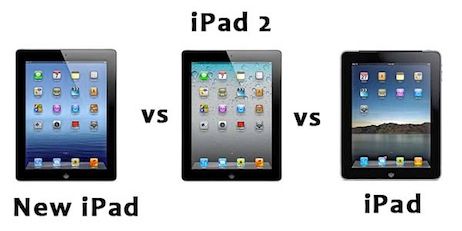
What number iPad are we now on? Even Apple doesn’t know and has just started calling it the NEW iPad. Expect the NEW iPad 3 (as opposed to the iPad 3, which technically is the ‘NEW’ iPad) soon then.
When it comes to tablets and phones we are also seeing updates to not only the operating systems, but the actual hardware every 9-12 months. It’s a rate of improvement which, apart from the PC, has never before been observed in mainstream technology and gadget land.
How can consoles possibly hope to compete? Both Xbox 360 and PS3 have operated on a 7-10 year life cycle, and largely they have been able to deliver a shelf life which has resulted in them still being relevant and current in today’s market. We have seen various firmware/OS updates to both platforms, which have resulted in improved functionality on the non-games side of the equation. However, when it comes to games themselves the specs are fixed and it’s been up to developers to find new ways of raising the bar when creating content specifically for the console. Any initial design flaws which the consoles launched with are issues which cannot always be worked around.
The PS3, especially, has had quite a few issues. Whilst first party content looks remarkable on this platform (God of War 3 and the Uncharted series come to mind), third party content, often designed for PC and Xbox first, has really suffered. The way in which the PS3 handles memory is so different to the Xbox that certain games look worse on the platform. Skyrim doesn’t even fully work, which has resulted in DLC for the game still lacking on the PS3 whilst Bethseda works on a solution to the memory issue plaguing its persistent world.

This is the original Xbox. In fact most of us probably still have one looking like this as opposed to the ‘Slim’. However the actual insides of the Xbox consoles have gone through quite a few changes. Mainly to reduce heat (and the console failing) and costs for Microsoft. The Elite, for example, was a very different beast to the original Xbox. No functionality has been removed (that I can think of) in each step, and in the situation with the Slim some was added (internal power for Kinect). Raw CPU and other specs though, stayed the exact same….
The Xbox lacking a Blu ray drive, and having some systems ship without a hard drive, is another example of hardware decisions holding back the platform (albeit this hasn’t been such an issue in comparison to the memory issue on the PS3).
Indeed, whilst the platform holders are busy working on new technology for their replacement consoles, there is an argument that simply upgrading the PS3 with way more memory (4-8 gigs would do it nicely!) would deliver a superb experience for the majority. The CPUs in the PS3 really are amazing and it’s the lack of memory that holds that platform back from consistent greatness. For sure, compared to a top of the line PC equipped with the latest graphics card the PS3 would need more than more memory to match it frame for frame, but most of us would cope – it’s the lack of memory that is the issue. Of course, they do not take up this option due to the Sega experience, and in reality it’s probably better to just continue to battle on with the existing tech, reducing its cost to produce and maximising sales where possible.
So, how do console manufactures make sure their offering isn’t redundant within nine months of release? Traditionally they offered a hardware solution that was so ahead of the curve it would take 24-36 months until the majority of PCs offered a similar performance at a similar price.
However, the number of units the phone and tablet producers (well, Samsung and Apple) are shipping per year are huge. They can offer tomorrow’s tech today and for less due to their economies of scale. Whilst Nintendo ship 5-10 million 3DS consoles in a year, Apple might ship 20-30 million phones, as well as tablets (which share much of the same technology). Not only that, but they will then replace it with a new model 9-12 months later.
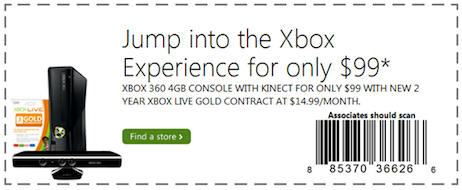
We are told that the Microsoft subscription offer HAS been a success. Proof will be the launch of it’s replacement.
Based on the current business model there is no way a console platform can keep up with that level of pace. Should Sony, Nintendo and Microsoft go down the route of releasing a new £300+ console every 12 months very few of us could afford it or justify the expense even if we could? However, if gaming moves to a contract or subscription based model, perhaps it could adopt such a fast level of upgrade as people take on 24 month contacts with upgrades, as with phones. Yet, we can’t be sure that enough of the user base would buy a console under such a regime, rather than buying it outright, resulting in a two-tier user base ‘progressing’ through the product line at different speeds. One upgrades every 24 months and one every 6 years!
As stated in previous articles, Microsoft is clearly testing the waters with its $99 subscription option with the current hardware, and in turn Sony is using PS Plus as a way of testing a “content for subscription” model. They are trying to see how much of the userbase would be willing to move onto such a pricing model. It would certainly allow greater flexibility when it came to hardware updates.
Ultimately, we would still have multiple versions of hardware with the consumers, as clearly they wouldn’t all sign up in the same week – resulting in overlapping upgrade dates. This is exactly how it is for the phone market. Is it possible for developers to create versions of their games that respond to the hardware it’s on? For sure – see how some Xbox 360 games shipped with ‘Hi-Res’ art discs for those with hard drives (whilst those without had lower resolution textures), and some iphone and ipad apps recognise the hardware and adjust accordingly, in the same way that PC games can have adjustable settings.
However, ultimately it’s difficult to package in a complete range of options (just ask Android developers, who have to contend with hundred of devices, some with gyros and some without for example) and even many iPhone devices perform poorly with the latest games or are just not able to run them. This is a situation console developers do not want and the market won’t easily tolerate. The cost of developing a Call of Duty compared to an Angry Birds dictates that it must be able to address the largest possible consumer base. This is why GTA 5 is coming out next year on existing consoles rather than as a launch title for the ‘next gen’. It uses an upgraded engine from GTA 4 and will allow Rockstar to capitalise on years of investment and development work.

The WiiU. A console which is very powerful in some areas, but lacking, especially when it comes to it’s CPU. It would benefit from an iPad style ‘update’ to a WiiU 2 in around 18-24 months. Will Nintendo be brave enough to offer this?
In the short term the Wii U will probably benefit from being based on tech from this generation (perhaps with a lower spec CPU, but balanced out by having tons of RAM in comparison to the existing two consoles and a decent GPU) as it will allow developers to bring games already slated for Xbox 360 and PS3 to the platform without too much additional investment. Some predict that this benefit will only last two years as by year three it’ll be overshadowed by new consoles which by then might have a large enough user base to become the primary development focus for the likes of EA and Activision. At that point developers will have to decide whether it’s worth trying make a sub-standard version of a ‘next gen’ game or simply ditch the platform entirely.
Of course, those ‘next gen’ consoles might themselves be overshadowed by our next TV or tablet. This is why it is almost certain that we will see some kind of subscription model and that the life span of PS4 will be only 3-5 years and not the 7-10 years PS3 has been around for. I would imagine the same will be true of the new Xbox. What will this mean for developers?
Well, the upgraded console (PS4.2!) will be simply that – an upgraded console, able to improve the base game but ultimately not a new platform. Developers will still be able to put one game on disc (or download) and the right assets will ‘play’ in the right version of the machine. It’s been well leaked that unlike with the PS3, Sony are putting in non-bespoke parts in the PS4 to make it easier to develop for, cheaper to produce, easy to source and – one assumes – easier to upgrade. This is part of a strategy to make sure that the PS4 is not just another platform but is one which is easily cross-compatible with other hardware in the market. The same reason why for the first time there is a version of Windows running on ARM processors for their new tablet range. Consoles can no longer be islands inaccessible to those creating content for other systems.
Of course Sony are not putting all their eggs in one hardware basket. Earlier this year they bought Gakai, a game streaming service. It is clear that this is one way in which they feel they can allow console gaming to improve continually without having to sell a new piece of hardware at all. Simply by having the game run on servers, which they can control and upgrade at their leisure centrally, without having to roll out hardware back into consumer’s houses.
Microsoft, too, is moving in that direction. They already have the internal resources needed to offer an online cloud solution, and it’s clear that Windows 8 is being designed in such a way that it could go from offering a ‘closed’ gateway download service to a closed streaming service. After all it is already streaming everything from Office to audio and video so a move to games, whilst technically far more complex, would be simple from a storefront/consumer experience point of view.
This is the ultimate offering and it’s clear that this is where we are heading. If this is successful, and to be so a lot will depend on the roll out of fast fibre optic broadband across the USA, Europe and Japan, then perhaps 2013/2014 really will be the last new generation of consoles to be launched with regard to each being a new platform with new technologies inside them.

PSPlus is perfectly placed to become the ‘PS5′ as the cloud route is clearly the big revolution round the corner. However no one is quite sure how long that corner is. Fast broadband exists, and is within the reach of the consumer. However, it is NOT cheap and until costs falls by at least 50% it will be a barrier to solutions such as the now Sony owned Gakai replacing a download or physical disc as a mainstream alternative.
So where does that leave Nintendo? Whether their console is ‘next gen’ or simply ‘this gen with a cool twist’ is irrelevant. They have launched a new console firmly grounded in the last gen business model. It’s a cash up front model, with no subscription in sight. It’s ironic as if there is one company who has the IP to justify a subscription to them alone, it would be Nintendo. Nintendo are the HBO of gaming as they have the richest and deepest set of gaming IP available. Sony are catching them up with regard to this with an ever growing (and often more risky) set of new first party IP and gameplay experiences. However as things stand today, Nintendo could adopt the subscription model aggressively without devaluing their core experience and income stream.
In addition whilst they are adopting the download market we see no signs that they have the ability, capacity or imagination to implement a streaming option. Heck, they can’t even launch a console without a large day-one firmware patch which their own servers couldn’t handle, resulting in hours of downloading for some disappointed day-one consumers.
We’re still in the early days of the Wii U, and it’s possible for Nintendo to launch both a subscription service and to get into a partnership with a technology partner able to offer them a streaming platform. On the basis the Wii U will soon be underpowered, they might, out of necessity, try to seek that partnership sooner rather than later as a way of keeping their hardware relevant without being forced to release a Wii U 2 in three years time. If Nintendo do strike out and decide to maintain this traditional business model then they will need to release a Wii U 2 in 3-4 years time, and accept splitting their userbase.

The same console in a new colour IS a successful marketing ploy (would you believe), but making that your only ‘update’ is now not an option.
We have witnessed Apple releasing the iPad 2, followed by iPad 3 with a 3+ then being released soon after. I don’t think Nintendo should fear following this trend, as consumers are now used to fast hardware iterations. As long as the user experience, settings, downloads and all content for the Wii U passes to the Wii U 2 seamlessly and as long as developers find they can release product for both easily in the majority of cases (perhaps with some products only supporting the latest version), then consumers will accept this rate of change. 2-3 years value from a tech product is an eternity in today’s world.
This expectation for ‘change’ itself is now part of what consumers want and expect. Hardware iteration is now old school. Hardware reinvention is what we demand and when the guy next door gets the new model that does so much more than our old one, simply creating a new, smaller and cheaper version of your platform doesn’t cut it anymore.
]]>
At E3 this year, Sony rejigged their PS Plus offering. Until E3, their £40 a year package had offered a range of free games every month. It generally included a PSN title, some minis, and a PSOne title, with a different mix served up each month. In addition PS Plus users get discounts on other content from time to time. I had hoped that Sony would take this opportunity to make PS Plus all encompassing with different tiers. The top tier for example might offer games, videos from their store and access to their Music Unlimited service. This though was not to be, perhaps with it being held back for the launch of the PS4 – potentially linked to the hardware in a way which is similar to a phone contract.
What Sony did, though, was to raise the game on the quality of content which was being offered through the PS Plus scheme. We still get our discounts, but instead of having Minis and other titles, Sony is offering ten PSN and full-blown BluRay titles to download at any one time. This list of games is updated with two swapped in and out every month. This list includes quality product which, whilst perhaps a year old, would be trading in secondhand bins or as discounted newly boxed titles from between £8-£19 each. Titles such as Motorstorm Apocalypse, or LittleBigPlanet 2, Saints Row 2 and Dead Space 2.

When PS Plus was a year old, the team at Sony baked this cake for all of us. How they got it to go round is still a mystery – we have enough problems cutting one 24 ways at our daughter’s birthday party.
This is an unbelievable level of content and choice, and from the perspective of the consumer is a win, win. Some might question how Sony can offer this for only £40 a year. However, the principles are simple – many of these titles’ sales have fallen to a trickle, and for the publishers involved in the scheme it offers some cash for a game which stopped contributing to their cash flow some time back.

Motorstorm was an amazing game which, whilst always being nothing more than a 1-2 million unit franchise, had its launch scuppered by events outside of anyone’s control. PS Plus has given it a new lease of life.
In some cases they are games which received critical acclaim but where the sales never matched the media interest. Motorstorm is a good example, in that it was delayed at the last minute due to the tragic events in Japan caused by the tsunami, and hence never recovered its momentum. For Sony, the investment has already been written off, and so this is a good title to utilise to tempt subscribers.
The other benefit to publishers is it’s a way of using titles which are no longer current to reinforce interest in certain franchises. Hence it is no surprise to find Dead Space – a critically acclaimed game where sales have never matched the buzz. It’s the kind of game I’ve previewed, played demos of, but never owned. Now Ill have a go at playing it in some depth prior to Dead Space 3.
The number of PS Plus users at present is not public, but if we assume it’s cautiously between 250,000 to 12 million people (Sony clearly would like it to be 20% of PS3 users or more – which would be around 12 million people) we see that we would have between £10 million-£480 million pounds in the kitty, allowing each publisher to receive anything from £400K – £15 million per title depending on the end deal with Sony (based upon 24 titles a year being offered). One would expect that Sony would have a sliding scale payment system to the publisher based both on number of subscribers and numbers of actual copies of the game downloaded. Similar to how record labels sometimes sign off music to magazines, this is a good cash deal for publishers.

Starhawk is a superb Sony exclusive, and would make a terrific ‘Free to Play’ title. It would make a great PS Plus title with DLC being paid for. Without being part of the PS Plus model it might still do okay, but its sale numbers will be nothing special.
There is a downside, similar to the problem faced with record labels doing deals with magazines/newspapers, which is that it reinforces over time a feeling that games are not really worth £40-£60. The consumer starts to think, and question the value of software, if a year after release they can get a similar calibre game as part of a £40 yearly subscription. The brain will, over time, start to entertain the notion that games are worth only £1-£2 in value. This is something that both Sony and other publishers need to be aware of.
However, it is not a concern if ultimately Sony doesn’t want to maintain the traditional boxed ‘pay as you go’ model and would like everyone on a subscription. Indeed, they – more than Microsoft – can help this to happen. Anyone watching this year’s E3 would have noticed that Sony have many, many first party exclusive games coming out over the next 12-18 months whilst the Xbox has very few. Sony have an opportunity to leverage this content across its userbase and utilise it as a way of enticing people to subscribe. Whilst there might be a few high profile releases which people still buy (Call of Duty for example) all their other games would be part of the subscription service.
On a personal level I’m already experiencing the effects on my buying habits. I’ve stopped looking at secondhand bins, for both Xbox 360 and PS3. Why? Well I’ve now got eleven games sitting on my hard drive, most unplayed, which I need to work through. Whilst I might not have chosen all those titles if I had been given a free choice, they are all good enough that I cannot justify buying another game when I have so many quality titles unplayed. Secondly, I’m unsure what the next two titles being released on PS Plus will be – and hence why buy a game which I might get free in a month or four anyway.
This PS Plus deal has the potential to kill the secondhand market (it won’t though, as it doesn’t have the critical mass of gamers on board yet), but in a way which is fair to both the publisher and consumer (unlike network passes). It potentially allows publishers to continue to invest in high quality games, but which might not sell much more than a million copies – as if they know in advance that it will be part of PS Plus they know that they will get a minimum of ‘X’ amount to justify the investment. Consumers get a never-ending selection of high quality titles, but with the headline price being £40 a year.

All publishers want to charge a subscription for their game. In reality very, very few can support it – as consumers we have too many services to subscribe to. Netflix, Lovefilm, Call of Duty, World of Warcraft, Google Drive, Music Unlimited etc etc etc. Star Wars’ subscriber numbers are falling off a cliff – hence they are adopting free to play. Free to play is based on the premise of a huge number of players interacting with the game resulting in a modest percentage then subscribing or utilising micro transactions. This model allows for a high level of player turnover. It’s like throwing mud at a wall and hoping some sticks……
It’s clear that apart from perhaps no more than 10-20 titles a year, the industry cannot sustain many titles with the development and marketing budget of a Call of Duty or GTA 5. This is why firms such as THQ are in trouble as it’s becoming increasingly hard to compete. At the top end of the industry games continue to become more expensive to develop and sell, whilst at the lower end we continue apace with free to play, advertisement funded games or cheap apps. Creating yet another app store, emulating iOS, Android and even to an extent Blackerry’s app store is now not enough to differentiate yourself in the market. PS Plus and what it represents seems to be the perfect way of allowing hardcore gamers have a wide selection of quality, AAA content in a way which is sustainable for all concerned. Indeed the games can still include micro-transactions/DLC for extra functionality and income streams after the initial main game is downloaded as part of the subscription, so there is still the ability for a game to do exceptionally well over time.

Over time expect one subscription (eventually with tiers), resulting in exclusive Sony owned (and third party) content accessible across devices. It’s the antidote to the appstore.
For a year or two now, ever since Activision decided to bring the World of Warcraft model to Call of Duty (via Elite) we have heard the mantra that games are becoming a service. With PS Plus, Sony have decided to create a service which provides games.
]]>
The EX-03 is a wired headset for chat only. It’s mono and attached to the 360’s controller chat output. The build quality is on the whole very good. As with other Giotek products, it’s themed along army lines, and you will feel a little badass using it. Of course, it’s made of plastic but it doesn’t feel cheap in your hands. It utilises a soft, padded form of plastic, a bit like a high quality dashboard, and feels good to the hands and ear. It’s lightweight with a good cable length. In addition the actual earpiece comes with a variety of sizes so you can make sure it’s as comfortable as you are going to get with a headphone that goes in your ear without going to an E and T specialist to get a mould!
The actual headphone comes to the side of the face without being intrusive, and then there is an independent volume wheel and mute switch along the cable, just like the official Xbox headset. The only complaint is that there are no markings on the wheel to show louder or softer, and the mute switch seemed a little insecure. These are minor niggles though.
The actual audio quality is superb. It is far better than a standard Xbox 360 chat headset, with both the volume available and the clarity being consistent and rewarding. You’ll now be able to hear that 12 year old kid dissing you in glorious audio Technicolour.
The second headset is the EX-05. This is a beast of a headset. It’s a fully loaded stereo headset, with chat mic. Ideal for people who live with wives or girlfriends who insist on watching ‘Strictly Take Me Out Dancing in Essex Whilst on Ice’ on a tablet in the same room and then complains that Call of Duty is too loud for them.

The cable is very long and connects to the USB slot on your console (to power the headset), and then to your TV, amp or the multi-out connector on the back of your PS3 or 360. The sound quality is good – don’t expect £200 Sennheiser sound quality, but there is a good mix of bass, mid and treble. It certainly is much, much better than your standard MP3 headphones, and as the speakers are going over the ears, they do a great job of blocking out any surrounding sound. Hence, even when you are not gaming, they can be of use when sitting next to your wife or girlfriend. Truly a useful investment.

As with the EX-03, the chat part works very well, with a good level of clarity both for incoming and outgoing signals. In addition the EX-05 can be used only for chat if you desire, even though the point of that is lost on me, as if the rest of the sound is coming out of your surround sound system then it will be subdued, due to the dampening effect of the headset. Better to use the EX-03 or the PS3 equivalent at that point.
Overall these are two very good products. Whilst these headsets can’t improve the quality of the chat you might hear over Xbox Live or PSN, they will certainly allow you to hear it all clearly, with the EX-05 also allowing you to game well into the night without waking up a soul.
]]>
- Format: Vita
- Unleashed: Out Now
- Publisher: Sony Computer Entertainment
- Developer: Nihilistic Software
- Players: 1 (campaign), 2-8 (multiplayer)
- Site: http://uk.playstation.com/resistancebs/
Let’s get to the crunch; the controls in general are excellent. Aiming, moving, zooming all feels very natural. It’s comfortable, and no cramp develops. Opening doors, using grenades and typical Resistance secondary fire options for the weapons are carried out via the touch screen. It works very well – we heard some reports of people throwing grenades instead of opening doors, or having a sense of awkwardness stretching their thumb across the screen, but didn’t experience any of those issues throughout the whole game.
What doesn’t work so well is sprinting. There is no ‘click in’ on the Vita sticks, so sprinting is achieved by either double tapping the rear touchpad or pressing down on the dpad. The rear touchpad option is awful, but the dpad works just fine and becomes instinctive before too long.
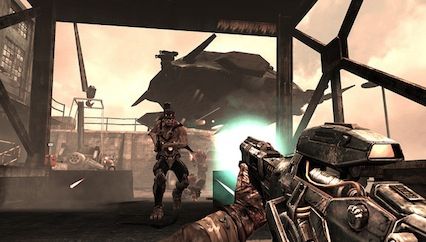
The game itself follows what seems to be less than a 24 hour period in the life of a New York fireman. He is called to a fire which turns out to be the start of the Chimera invasion of the USA. He has the ability to instantly pick up and understand alien guns (as all firemen do), and take on the naughty aliens. The plot line is too unbelievable, with his family running into him whilst on the job. They are then separated, and end up being placed in danger by the government’s evacuation plans. Consequently, a story develops where your character teams up with a lady from the resistance to return them to safety. There is a moment of real emotion in the game, but it stands out like a sore thumb surrounded by an oasis of narrative drivel.
The level design is very linear and the enemy AI, whilst good, is simplistic. From time to time an enemy combatant will try to outflank you, but it’s really just a matter of ducking behind cover and shooting your way through the room or closed-off street, followed by another room or closed-off street. The skill is in balancing your guns and ammunition rather than outsmarting the Chimera.
Whilst it doesn’t look bad, it doesn’t look amazing; it can’t hold a candle to Uncharted: Golden Abyss. While each level loads into the device’s memory an animation is played trying to deliver some wider context to the story. The art style is 2D with a 1950s crackly effect, which is just fine. However there are huge amounts of pixellation and artefacts across the screen. This is unacceptable. In addition the music (which is excellent) often cuts out for no reason, leaving the game very quiet for long periods of time. Whilst some of this might be an artistic decision, some of it just seems buggy.
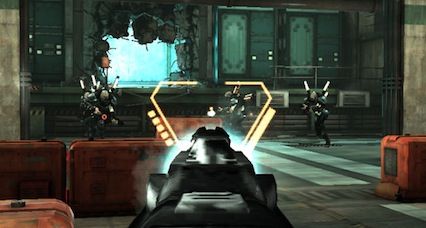
The campaign will not take you long, even on the hardest difficulty. So once that is completed you’ll want to play the multiplayer. There are very few modes available, with most being derivatives of deathmatch. Once again, it’s great to play a FPS multiplayer properly on a handheld device but it’s too little content. Once a better alternative is released, this game won’t retain its community.
If this was a tech demo we would give it 10/10 – but it’s not. It’s a £40 product which should offer £40 worth of value. The missing music and sloppy loading animations, the short life span and mundaneness of the campaign compounded by a very limited set of multiplayer modes drags this down. So should you buy it? Clearly Sony are banking on people being really desperate to play a FPS on their shiny new Vitas. As long as you buy it with your eyes open knowing what you are going to get (or not get in the case of this game) you will have a good blast. However, if it’s a choice between Unit 13 (which is cheaper, but offers far more gameplay) or Resistance, then our advice would be to let the skies burn away without you.


Consistent with general Giotek look and feel, this shouts Military shooter lover in every way!
Controllers and gaming go together like toast and Marmite, Cameron and Clegg, and Pinky and Perky (some might argue that those last two examples are in fact repetition). We spend more time in contact with our controllers than with the actual consoles we covet so much. Yet these controllers are not always treated well by us. They run out of power in the middle of a game and then get thrown on the sofa or floor, or stuffed into a drawer when not in use. Giotek have set out to solve the issue of keeping the controllers fully juiced whilst also keeping them stored neatly and easily accessible at all times.

The AC-1 in action
I’ve been sent two products for Xbox 360 owners (there are also PS3 versions, which I have not been able to test). The first product, the AC-1, is beautifully designed. It is slightly thicker than a DVD case, similar to the tin cases some special edition games come in. It’s made of metal and opens out to reveal two red charging connectors and placements for the controller to sit in. Connect the spine of the case to your console via the supplied cable, connect the controllers and hey presto, instant dual charging. This all in a unit that is transportable, neat and very cool to have by the side of your console. You’ll know it’s charging as a simple LED light on the stem shows you the device is connected and charging. The styling is superb, but more on that later.
The DF-1 on the other hand is a charger on steroids. It’s fashioned like an ammunition case and comes complete with two contact charging batteries which replace the original controller’s battery compartment. It’s not a 100% flush finish compared to the original battery, but it’s as good as and adds no discernible extra bulk to the controller.

There is plenty of room in the DF-1. It’s the Hummer of game controller chargers!
As with the AC-1 there is room for two controllers, as once you open the lid (complete with army style lock mechanism) two controller housings are presented to you. Insert the controller and instant charging. You’ll know it’s connected and working via a flashing red light on the outside of the box, which eventually will turn green. Giotek have really thought about the end user and the community it’s appealing to. Nothing is cheap to touch or look at. The LED lights gently throb and their hue and timing are almost Applesque (but more macho of course) in their elegance.
Many of us own an additional console, and what is great about the DF-1 is that whilst the two Xbox controllers are in their housing there is room for a Wii controller down the middle of the box. Heck, I’ve even squeezed in a PS3 controller. Of course they are not able to charge, but it’s a neat place to put them all even if the lid can only close three quarters of the way as a consequence. My wife still reckons it’s neater than having them spread across the coffee table. She suffers from controlleritus you see. Before the days of the Wii, PS3 and 360 she suffered from Wireitus, but that’s been dealt with by the console manufacterers.

Even my wife likes this. Or maybe I just convinced myself she likes it? Either way it’s still where I left it with no cushion yet placed upon it, so that’s gotta count for something.
As I hinted at earlier, Giotek have taken the styling of these chargers seriously. The AC-1’s case is covered in a camouflage image with a Gears of War meets Modern Warfare art scheme mixed in for good measure. The typeface work on the cover is military in style, with the description of ‘ammo clip’ on the side being a wee bit tongue and cheek. The DF-1 is clearly larger, being the size of a small tool kit. It too has a camouflage look and feel with a similar Call of Duty style typeface on the top. In the age of limited edition box sets, figurines and customised consoles, the DF-1 looks the business! It’s functional and for those of us who like to show off our gaming rigs and merchandise it’s a superb and useful accessory to have by our consoles. My only criticism is that I would have taken the styling even further with more images on the side or, if it didn’t affect the end price too much, even USB sockets to make it a hub.
It should also be stated that Giotek tell me that both the AC-1 and DF-1 for Xbox 360 work with their own Xbox 360 controllers. All in all, these are useful investments if you want to always have charged controllers at hand and a happy wife who now has no reason to constantly rearrange and ‘hide’ your Xbox controllers.
]]>